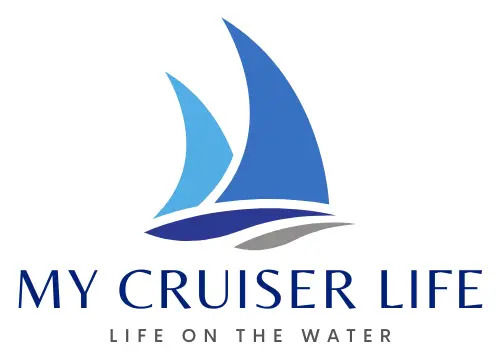There are dozens, if not hundreds, of names for the many varied types of sails found on sailboats. Sailboats have been plying the waters and oceans of the world throughout history. When sailors had dozens of sails on board, they would need to quickly and concisely identify each sail, and each sail had a specific name.
Today, most modern cruising sailboats have just a few sails. The most common sails are the mainsail and the jib.
Table of Contents
- Common Sailboat Terms and Sail Types
- Points of Sail and Wind Speed
- Types of Rigs
- Sailboat Sail Names
- Types of Sails
- Gaff Rig Square Sails
- Lateen Rig Sails
- Types of Sails on a Ship
- Types of Sails on a Sailboat
- FAQs – Sails on a Boat
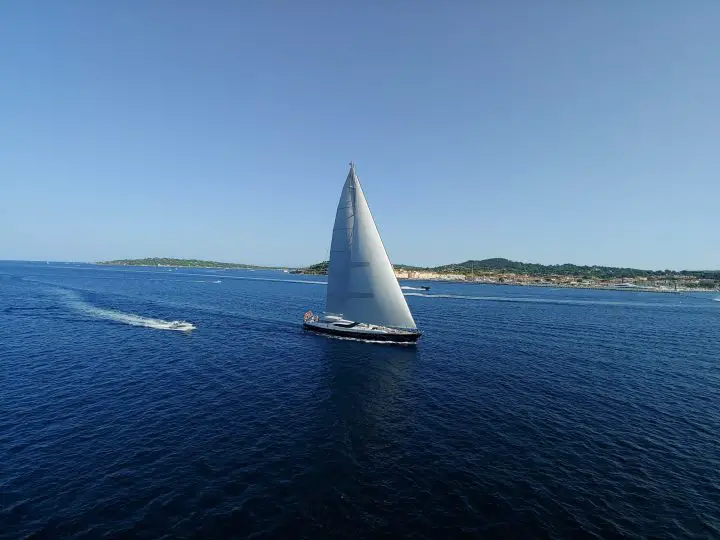
A sail’s job is to harness the power of the wind to get the boat moving. Selecting the right sail combination will get your sailboat moving fast and efficiently.
The sails each do different jobs in different wind conditions. The mainsail is aptly named. It’s the main sail and can be used in most wind conditions.
Sailboats may have just one or two sails onboard, or they may have a large assortment. Boats that race usually have many sails so that they can use the best sail combination to win.
Common Sailboat Terms and Sail Types
Mast
A mast is a strong wood or metal pole that stands vertically on a sailboat. Its job is to provide a stable way of raising the mainsail and keeping the mainsail steady.
Mizzen Mast
On a two-masted sailboat, the aftmost and smaller mast is known as the mizzenmast. The mizzen sail is hoisted on it.
Boom
A boom provides structure and attachment points to the foot, or bottom, of a sail.
Halyard
A special line that pulls a sail up to hoist it. When sailors are ready to put away the sail, they can release the halyard, and the sail will drop.
Roller Furler
A device that rolls a sail around a stay or inside a mast. A stay is a sturdy piece of rigging that helps keep the mast in place. A sail that is rolled on a furler can be easier to store and manage.
Hanked
A hanked-on sail is a sail that doesn’t use a roller furling. Hanked-on sails are more traditional. This sail is stored in a bag instead of on a roller furler. To raise a hanked-on sail, the sailor must walk to the sail’s location and raise the sail using a halyard.
Points of Sail and Wind Speed
Apparent Wind Angle (AWA)
The apparent wind angle describes where the wind is coming from in relation to the sailboat. Let’s think of the sailboat as its own compass. The bow of the boat is 0 degrees. The side of the boat is 90 degrees. The stern (back) of the boat is 180 degrees. If the Apparanant Wind Angle is 160 degrees, the boat is headed almost downwind. Different sails are used in different AWA scenarios.
Close-Hauled
Close-hauled means the boat is sailing upwind. You can’t sail directly into the wind, but you can sail “close” to it. A boat sailing an AWA of 45 degrees is closed-hauled.
Reaching
Reaching is often a preferred point of sail because it’s easy to manage. When a boat is reaching, the wind is coming from the side. A boat sailing an AWA of 90 degrees is reaching on a broad reach. At an AWA of 135 degrees, the boat is on a broad reach.
Sailing Downwind
A boat that is sailing downwind has the wind behind it. So, for example, if your AWA is 180 degrees, you are sailing dead downwind. Spinnaker sails are examples of a downwind sail.
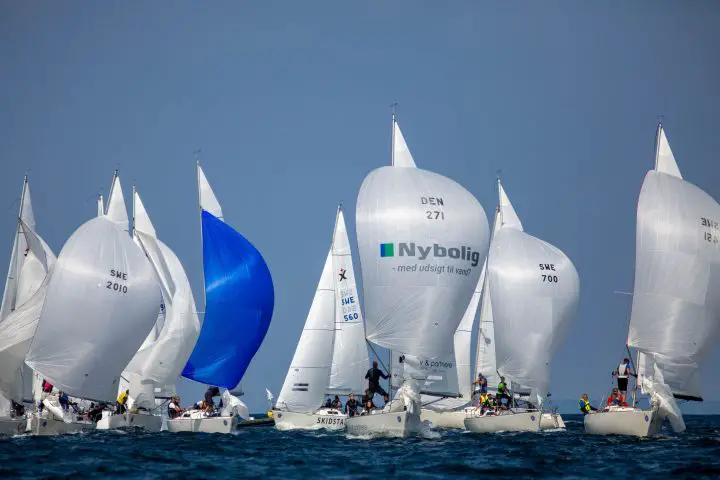
Light Air
Light air refers to low-speed speeds. Anything less than about 12 knots is considered light air. Sailors will want to use light air sails to get the most out of light air.
Heavy Air
Heavy Air refers to stronger winds. Any wind over 20-25 knots is considered heavy air. Sailors will want to reduce sail and use heavier sails to prevent damage to the sails.
Types of Rigs
What type of sails are on a boat depends on the sail’s rig. A sailboat’s rig design describes how many masts it has, where the masts are, and what type of sails it uses. There are different names for each mast configuration. The most common, single mast sailboat is called a sloop.
For example, a Bermuda rigged sloop has one mast, a mainsail, and a jib on the boat’s bow. A catboat has one large sail on a mast that is forward of the boat’s bow.
Bermuda or Marconi Rigged Sloop
The Bermuda rig is what is found on most sailing yachts today. The rig type was originally built in Bermuda in the 17th century. The term “Marconi Rig” comes from Guglielmo Marconi, who invented the radio in the 20th century. The standing rigging reminds people of radio masts.
The Bermuda sloop rig features a single mast with a mainsail attached to a boom. In addition, Bermuda rig sailboats have a jib mounted on the bow. On a fractional rig sloop, the arrangement is the same but the jib is much smaller. Instead of being mounted at the masthead, it is attached lower down the mast.
Lateen Rig
A lateen or Latin rig is one of the most traditional sail-rigs. This sail type was revolutionary in early history as it allowed sailors to sail into the wind. Before the lateen rig, square sail sailing vessels could only travel downwind. Romans used the lateen rig to navigate Europe. The lateen rig features a triangular sail set at an angle. It has a yard, or spar, at the top of the sail to provide structure. This rig isn’t common on sailing yachts, but it is common in the Mediterranean and the Indian Ocean.

Ketch
The ketch features two masts. The main mast is similar to the main mast on a Bermuda rig. The second mast, called a mizzenmast, is smaller and set forward of the rudder. Ketches also have a jib mounted on the bow. Ketches are popular as they allow sailors to carry a large sail area that is manageable.
Yawl
A yawl has two masts and is similar to a ketch. However, the smaller mast, or mizzenmast, is set aft of the rudder. A yawl’s mizzen boom overhangs the stern of the boat.
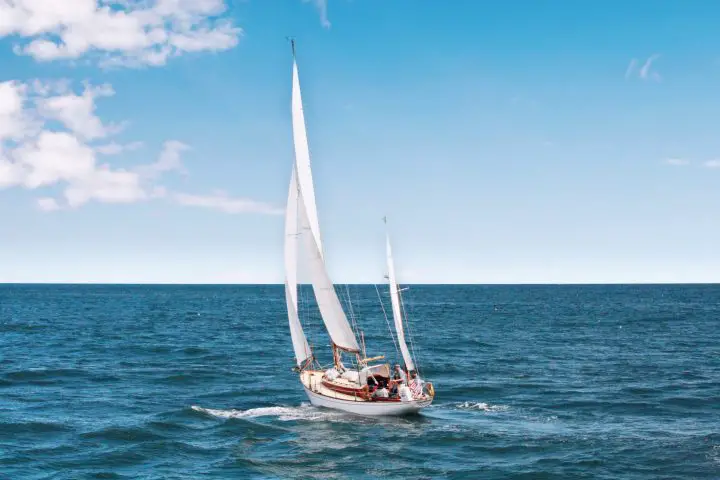
Schooner
A schooner has two or more masts. On most masts, the mainmast is usually taller than the foremast. However, some schooners have masts that are all the same height. Schooners might have two, three, or four masts. They often feature gaff-rigged sails. These beautiful, traditional boats were popular from the 17th to the early 20th centuries.
Gaff Rig
Gaff-rigged boats can be sloops, schooners, ketches, or yawls. A gaff-rigged boat has a large mainsail attached to the mast. The gaff sail’s foot (the bottom of the sail) is usually attached to a boom. On a sloop, there will be just one gaff mainsail. On a schooner, there will be two gaff-rigged mainsails. The gaff-rigged boat always has more than one sail. For example, gaff-rigged boats may have several headsails. Gaff-rigged boats were popular in the late 19th and early 20th centuries and won many America’s Cup races.
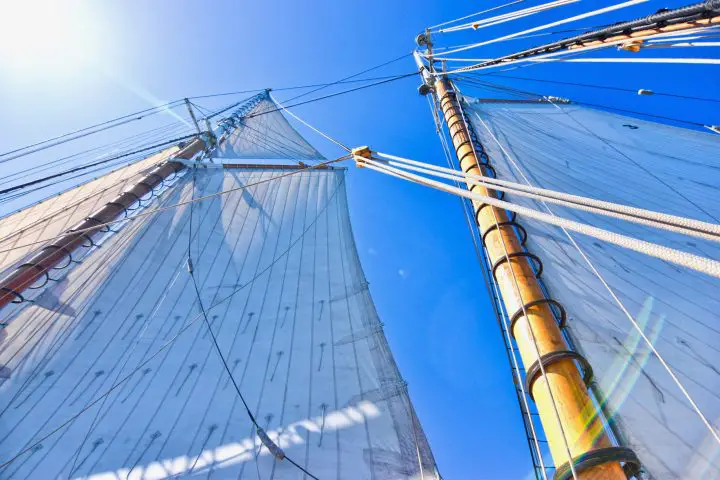
Catboat
A catboat has a mast that is forward on the bow. It usually has one big gaff-rigged sail. It’s different from a gaff rig because it has just one sail. Most catboats are under 26 feet in length. A few catboat designs have Marconi-style sails, which are triangular instead of square.
Sailboat Sail Names
Let’s focus on the types of sails carried by most modern cruising boats. Most of today’s cruising and liveaboard boats are Bermuda rigs, followed by ketches and yawls. For the sake of simplicity, we’ll assume that our standard boat with standard sails has a Bermuda rig.
- Mainsail
- Jib
- Genoa
- Spinnaker Sail
- Gennaker
- Code Zero
Types of Sails
Mainsails
The mainsail is the most important and most used sail on a sailboat. The mainsail is attached to the main mast and the boom. On a Bermuda rig, the mainsail is usually triangular.
The mainsail is raised up the mast using slides that fit inside a sail track. The mainsail, once raised, provides most of the lift needed to move a sailboat. When wind pushes on the sail, air particles rush over both sides of the sail. The particles on the outside, curvier side of the sail have a longer distance to travel. As a result, they speed up and travel faster and form a low-pressure area. The particles on the inside of the sail are moving slower and create a high-pressure area. The difference produces lift and moves the sail forward.
Most cruising mainsails have reef points. Reef points give sailors the ability to reduce the size of a sail. When it gets too windy, sailors can reef the sail and not overpower the boat or damage it. Sailors need to reef sails to provide a more comfortable ride, keep the boat controllable, and lessen the risk of damage or capsize. A reef point allows the sailor to take down the lowest part of the sail and tie the mainsail at a new, smaller size.

Mainsails with Battens
Some mainsails are full-batten. A batten is a flexible insert, often made with plastic, that fits in an insert on the mainsail. The battens are in line with the boom and are inserted fore-and-aft. These battens help the mainsail keep its shape and prevent the sail from flapping loosely.
Mainsails with Partial Battens
A partial batten mainsail features battens that don’t run the whole width of the sail. Because the sail is more flexible without full battens, sailors can more easily adjust the sail’s shape. Battens are heavy, and the added weight might decrease performance, so many sailors choose to have a partial batten sail.
Mainsails with Square Tops
Some boats have mainsails that, instead of completing the triangle, are squared off. A square top mainsail has more sail area and therefore should improve the boat’s performance. Square top mainsails are popular with boaters that race or want to get the most out of their sails performance.
Furling Mainsails
Most mainsails are attached to the mast with slides. When not in use, the mainsail sits on the boom in a sail cover. However, there are newer ways of storing and managing mainsails. Furled mainsails are becoming more popular. An in-mast-furled mainsail is similar to a jib on a roller furler. The sail is stored inside the mast and rolled out and rolled back in.
Some modern sailors opt for boom-furled mainsails. This type of mainsail is stored inside a specially-built boom. The sail is raised by unrolling the sail. Sailors can reef or reduce the sail size by rolling some of the sail back up.
Headsails
Headsails are mounted at the head of the boat, usually attached on a the forestay from the bow to the top of the mast. A jib is one of the most common types of headsail.
A jib’s purpose is to generate lift and reduce the mainsail’s leeward side turbulence. A jib can be used in most sailing conditions and apparent wind angles. For example, if the boat is headed downwind, the jib might be flown by itself. Or, the jib might be poled out to port while the mainsail is sailed to starboard. This type of configuration is called wing-on-wing.
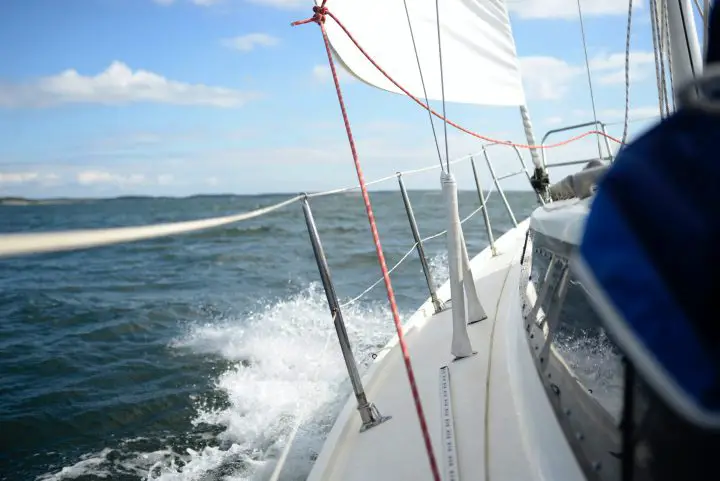
Roller Furled Jibs
Many modern cruising boats have roller furled jibs. The jib can be easily unfurled when the sailor is ready to use it and furled back up for onboard storage. Sailors can reef, or reduce, the sail area by rolling the jib in a small amount. Sailors can control a roller-furled jib with sheets (lines) that lead to the cockpit.
Hank-On Jib
Hank-on jibs are stored in a bag and raised with a halyard. This requires a sailor to physically move forward to the bow to raise the jib. However, a roller furler requires maintenance and can get stuck, so a hank-on jib might be considered more reliable.
Headsail Percentage
You might have heard sailors refer to a percentage along with a jib. For instance, a boat might have a 110% jib or a 135% genoa. This percentage refers to how much area the sail uses within the forward triangle. For example, a 100% jib takes up 100% of the fore-triangle. A 115% jib starts to overlap the mast. Most standard jibs are between 100%-115%.
If a boat sails in an area of heavier winds, it is likely to have a jib as a headsail instead of the larger genoa.
Genoa Sail
A genoa is a headsail. This sail is similar to a jib, but it is larger. Genoas overlap the mast. Most genoas overlap the mast by 120%-150%. So if someone says they have a 130% headsail, they have a genoa. Genoas work better than jibs in areas of lighter winds. This is because their larger size allows them to capture more wind. Since many boats have roller furlers on their headsails, a large genoa can be rolled up slightly and flown as if it were a smaller jib when the wind pipes up.
Staysail
A staysail is smaller than a jib and located just behind the jib sail. When a Bermuda rigged boat has a staysail, it is called a cutter. The staysail offers the sailor an additional sail area. If the boat is headed upwind in good sailing conditions, the staysail will provide lift. The staysail is often used along with a reefed mainsail and provides stability to the boat.
Downwind Sails
Most sailors dream of downwind sailing. It’s easier on the boat and crew to fly along with the wind at your back. Downwind sailing can also mean light-wind sailing. A downwind sail is often made of lighter sail cloth and provides the most sail area possible.
Symmetrical Spinnaker
A spinnaker is a very large and often colorful sail mounted at the bow of the boat. A spinnaker almost looks like a parachute and is built to offer as much sail area as possible. A symmetrical spinnaker has the same shape on either side of its centerline.
A spinnaker can be used when the AWA is between 90 degrees and 180 degrees. In addition, they can be flown when the wind is between three knots and up to 20 knots.
Most boats use a spinnaker pole to give the spinnaker a proper shape. A spinnaker is often considered hard to manage because sailors must spend time to set it up correctly. In addition, it can be challenging to take down if the wind speed increases. This large sail is also challenging to store on a boat.
Asymmetrical Spinnaker
An asymmetrical spinnaker has a more triangular shape than a symmetrical spinnaker. Asymmetrical spinnakers are known to be easier to set and manage than symmetrical spinnakers. Racers usually prefer symmetrical spinnakers, and cruisers usually prefer asymmetrical spinnakers.
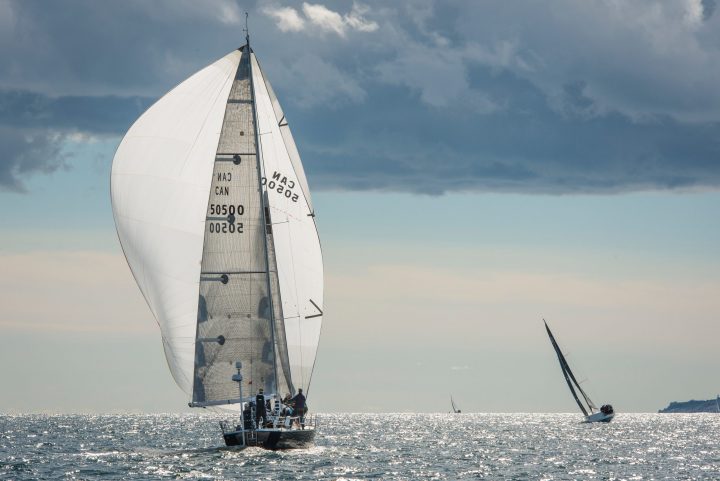
Gennaker
A gennaker is a combination of the best parts of a genoa and a spinnaker. A gennaker can be mounted on a furler, making it easier to store and manage. A gennaker is attached like a genoa but has more girth like a spinnaker. It is popular among cruisers who want the performance of a spinnaker but the easy handling of a genoa.
Code Zero
A code zero sail was originally created for racing boats but has become extremely popular on cruising boats. It’s lightweight and can be used in more wind conditions than a spinnaker. It is used to sail in light air and can be used when the sailboat is reaching.
The code zero sail can also be used when the boat is close-reaching or going closer to the wind. Depending on the exact sail plan, code zeros can be used when the apparent wind angle is between 45 degrees to 180 degrees.
Code zero sails can be flown when the wind speed is between about five knots and 25 knots. Because it is heavier than a spinnaker, it can be used in higher winds.
Code zeros are much bigger than other furled headsails and can be twice the size of a regular jib. A code zero sail can be stored on a roller furler, making it easy to store and use.
Drifter
A drifter is a large sail that’s used in very light winds, usually less than 10 knots. It can be used when the AWA is between 45 degrees and 180 degrees. Because a drifter is large, hard to store, and only usable in the lightest of winds, it is not commonly used on cruising boats.
Stormsails
Most cruising boats sail in decent weather conditions and can reef their mainsail and jib and keep sailing. However, in storm conditions, a storm sail could be flown. A storm sail is small and made of heavy sailcloth. Its purpose is to keep the boat steady in storm conditions.
Storm sails can be attached to the forestay or to the mainmast. A storm jib is attached to the forestay, either in place of or over the rolled jib. A trysail is attached to the mainmast.
Gaff Rig Square Sails
A gaff-rigged sail has a spar or pole on the top of the sail. It is also attached to the mast and boom. Gaff-rigged sails look almost square. Because a square has more area than a triangle, these sails have more sail area. The mast on a gaff-rigged sailboat is often shorter than a comparable Bermuda-rigged boat. A gaff rigged mainsail can be shorter because it has increased area.
Lateen Rig Sails
The lateen sail is triangular and has a spar that runs from the boat’s bow to the top of the sail.
The lateen was the world’s earliest fore and aft rig sail. This type of sail revolutionized transportation during medieval times. The Romans were the first to start using a lateen rig in the Mediterranean. This new style of rig meant that sailors could sail more into the wind. Previously, sailboats were rigged with square sails that could only sail downwind.
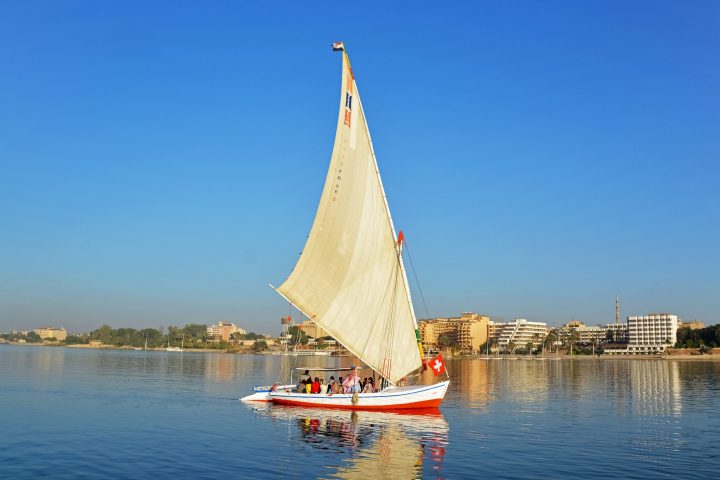
Types of Sails on a Ship
Traditional ships had a significant amount of sail area spread across a host of sails. Each sail had a specific name so that sailors could easily communicate. Additionally, each different mast configuration has a different name. Ships can carry up to six masts. A fully-rigged ship is one with square rigs on three or more masts.
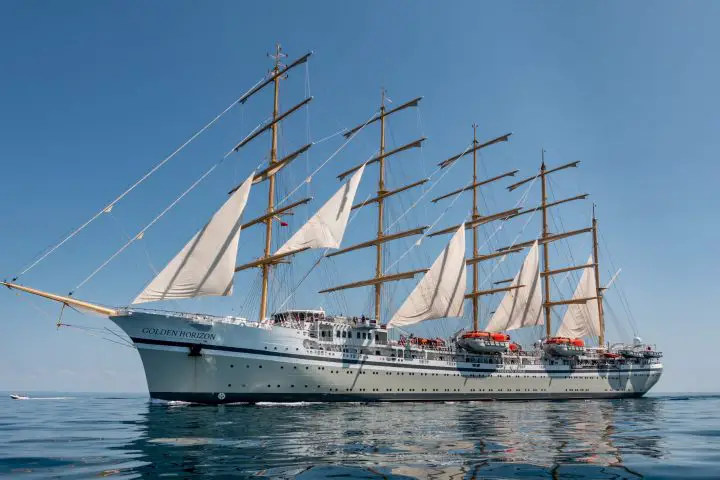
Traditional Square-Rigged Sails
Traditional ships came in a variety of sizes. Each ship was built to its own custom specifications. For the sake of simplicity, we’ll look at the rig on an 1850s sailboat.
This boat has three masts and 25 sails in total. Before engine power, sailors relied entirely on the wind to move their ships. Faster ships meant that produce had less time to spoil. The faster your ship was, the more competitive it was. Arriving with the first batch of sugar or fine wine would gather more interest and excitement at the dock than arriving three weeks later.
This ship has four headsails at the front of the boat. The headsails include the flying jib, the outer jib, the inner jib, and the fore topmast staysail.
Each mast has five or six sails, and each sail name on each mast starts with the name of the mast. For example, the most forward mast is the foremast. Each sail is a fore-sail. Thus, the foremast’s sails include the forecourse, fore-topsail, foretopgallant, fore royal, fore staysail, and fore moonsail.
Between the foremast and the mainmast, there are three staysails.
The main mast has the same sails, but each sail name begins with “main” — main course, main topsail, etc.
The mizzenmast, which is located on the aft of the boat, has five sails. Each sail name starts with the word mizzen –
– mizzen topsail, etc.
Finally, at the aft of the boat, there’s a gaff-rigged spanker sail.
As you can see, traditional sailing ships had a large assortment of sails that kept the boat moving in all wind conditions.
Types of Sails on a Sailboat
Sailors could carry many different sails on a sailboat. If you are into racing, you’ll likely carry a wider variety of sails. Racers often carry sails for every wind condition to get the most speed from their boat. Racing sailboats often have many crew members that don’t mind frequently changing sails.
On a cruising sailboat, the dynamic is different. Often, cruisers may be sailing with just one other person. Space is devoted to supplies and comfort instead of a huge inventory of sails. With a small crew and fewer exacting time restraints, cruisers might not want to change their sails every few minutes.
Cruising sailboats usually carry at least a mainsail and a jib or genoa. In addition, cruising sailboats that spend a lot of time sailing downwind or in light air might have an additional light air sail, such as a spinnaker, gennaker, or a code zero.
FAQs – Sails on a Boat
How many sails are on a boat?
Most cruising sailboats carry at least two sails, the mainsail, and the jib. Many cruising sailboats carry additional sails such as a staysail, code zero, or storm sail. A racing sailboat might carry up to a dozen sails. Traditional sailboats have many sails– a large sailing ship usually carried around thirty sails.
The number of sails aboard each sailboat depends on the boat’s rig design, the sailor’s goals, sailing area and average wind conditions, and the sailor’s preferences.
